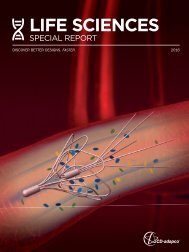Life Science Special Report December 2015
The Life Sciences Sector is experiencing an unprecedented change...
The Life Sciences Sector is experiencing an unprecedented change...
- No tags were found...
Create successful ePaper yourself
Turn your PDF publications into a flip-book with our unique Google optimized e-Paper software.
PHARMACEUTICAL CONTINOUS MANUFACTURING LIFE SCIENCES<br />
CASE STUDY TWO:<br />
EULERIAN MULTIPHASE (EMP) MODELING FOR MIXING<br />
FIGURE 4: Mixer model showing the effects of increasing gas injection rate using STAR-CCM+<br />
EMP modeling provides an effective means for studying the<br />
interacting streams and randomly dispersed phases in multiphase<br />
fl ows. The EMP model in STAR-CCM+ includes an extensive range<br />
of sub-models such as break-up and coalescence models for<br />
bubbles and droplets, and a granular fl ow model for particles.<br />
Figure 4 demonstrates an EMP simulation of a gas-liquid mixer<br />
with three rotating impellers. Shown are the effects of increasing<br />
gas injection rates on gas. The ability to predict gas<br />
hold-up, a parameter that governs mass transfer across<br />
the phases and consequently rates of reaction, is a key<br />
enabler in the design of such reactors. This approach<br />
adds valuable scientifi c insight into the decision-making<br />
criteria to develop practical solutions for mixing and<br />
other processes in continuous manufacturing.<br />
physics engineering simulation tools such<br />
as STAR-CCM+ can accurately deliver<br />
full spectrum engineering results and<br />
the pharmaceutical industry should fully<br />
leverage these tools in support of the<br />
development of continuous manufacturing<br />
processes. Up until now, integration of<br />
numerical simulations in a production<br />
environment has required a great deal of<br />
specialized knowledge, but this is no longer<br />
a showstopper. Automation and ease-ofuse<br />
are enabling the deployment of CFD<br />
for complex multi-physics applications.<br />
For example, STAR-CCM+ offers state-ofthe–art<br />
meshing, seamless integration<br />
with CAD and easy modeling of complex<br />
moving parts, all in a single integrated<br />
environment. The net result is more time<br />
for an engineer to analyze data instead of<br />
preparing and setting up the simulations,<br />
resulting in engineering success.<br />
Seeing the “big picture” for continuous<br />
manufacturing will require a multiphysics<br />
approach to solving problems.<br />
Be it mixing, coating or drying,<br />
multiphase fl ows lie at the core of the<br />
pharmaceutical processing industry.<br />
Capabilities such as Discrete Element<br />
Modeling (DEM), a numerical method<br />
for computing the interaction of a<br />
large number of small particles, and<br />
Eulerian Multiphase Modeling (EMP),<br />
a numerical method for simulating<br />
several phases in a system, will be<br />
invaluable for implementing continuous<br />
manufacturing of APIs. The two<br />
case studies in the article nicely<br />
demonstrate these capabilities.<br />
CONCLUSION<br />
In today’s competitive climate,<br />
manufacturing must become leaner<br />
with a focus on building quality into<br />
the process. Continuous manufacturing<br />
for the pharmaceutical industry will<br />
change the way drugs are made and<br />
multi-physics CFD simulations offer<br />
a cost-effective way to perform rapid<br />
prototyping for design of new equipment<br />
and processes. In particular, design<br />
optimization tools and powerful<br />
multiphase models such as DEM<br />
and EMP will play an important role,<br />
and the pharmaceutical industry<br />
should fully leverage these state-tothe-art<br />
technologies for the design<br />
and implementation of continuous<br />
manufacturing processes.<br />
REFERENCES:<br />
[1] “A Defi ning Moment : The Future of Manufacturing in the US”, Presented at The Future of Manufacturing in the US Conference, MIT, May 8-9, 2012<br />
[2] Plumb, K. Continuous Processing in the Pharmaceutical Industry : Changing the Mindset, Chemical Engineering Research and Design, 2005, 83,<br />
730-738<br />
[3] “The FDA Critical Path Initiative and its Infl uence on New Drug Development”, Woodcock J., Woosley, R. , Annu. Rev. Med. 2008. 59:1–12<br />
[4] “Pharmaceutical cGMPS for the 21st century” - A Risk Based Approach (http://www.fda.gov/ohrms/dockets/ac/03/briefi ng/3951B1_02_<br />
Pharmaceutical%20cGMPs.pdf)<br />
SPECIAL REPORT<br />
11



